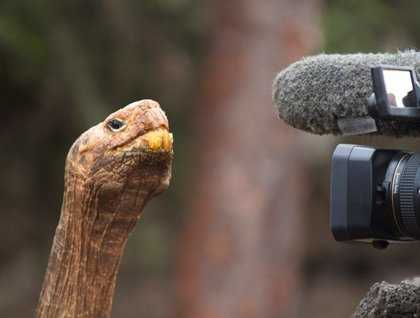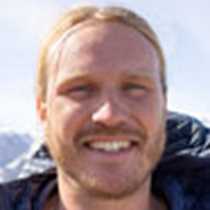We left our peaceful anchorage on the northern coast of Floreana at 0300 and in three slightly rocky hours reached Academy Bay at the southeastern corner of Santa Cruz Island. Here, just before dawn, Captain Pablo Garces had our boson drop the anchor of the National Geographic Islander. Academy Bay is named for the California Academy of Sciences, an institution that supported important scientific collecting expeditions to the Galápagos Archipelago in the early 1900’s. The town of Puerto Ayora has grown up around the fringes of Academy Bay and is now the largest city in the islands. There are well over 20,000 inhabitants here and many work in tourism. Fishing and agriculture are two other important occupations. Puerto Ayora is home also to the headquarters of both the Galápagos National Park Service and the Charles Darwin Research Station.
We disembarked on the national park dock and visited the extremely successful captive tortoise breeding center. Here we saw the diminutive and amazingly cute hatchling tortoises and learned about “Super Diego.” Diego is a male tortoise that was taken from the island of Española, and later returned to Galápagos. Since his return a couple decades ago, Diego has been a champion reproducer and has played a huge role in turning a mere 15 surviving adult tortoises into a healthy population of over 2000! I am suggesting that Diego is going to be a much bigger star than the famous Lonesome George – the last tortoise of his species from the northern island of Pinta, and who died of old age – last June. Poor ole George was a sad story and Diego is a very happy one! May his fame spread far and wide – he has brought an entire species back from the brink of extinction. As you can see from today’s photo Super Diego knows he is going to be a big celebrity!
We walked along the coastal road through town shopping for souvenirs and t-shirts in friendly and colorful boutiques and enjoyed in particular the fish market where juvenile pelicans begged for handouts and scraps. When we reached a small café called The Rock we gathered for a drink of juice and then boarded buses with our guides to head into the highlands. The vegetation changed completely as we left the arid coast and entered the lush agricultural zone. We stopped at a family run coffee and sugar cane farm and were entertained by their simple hand processing techniques and enjoyed tasting their products. It turns out that fresh squeezed sugar cane juice, with a touch of bitter orange and with or without a generous splash of sugar cane liquor, is quite delicious!
Lunch was at a rustic restaurant with a marvelous view where we helped ourselves from a variety of dishes on the buffet table. We took turns backing into a large empty and dry giant tortoise shell for comical and unique pictures, and then boarded the buses to drive to the lower down the slopes of Santa Cruz in search of wild tortoises. They were neither hard to find nor shy – and to our surprise we even found a couple of mating tortoises not far from the road! We walked through lush grasses in search of the biggest ones and took many pictures.
We admired a lovely barn owl in the women’s restroom where our buses were parked and many of us explored a double decker lava tunnel. The buses then took us back down to town and some of us opted to return to the ship for a rest (after all we have begun to like the idea of an afternoon siesta…) while others explored the town further or supported the local artisans economically with their purchases. The director of the Charles Darwin Station, Swen Lorenz, spoke to us during our evening gathering in the lounge and explained some of the current research projects and conservation programs. He reminded us that Galápagos is one of the very last intact island ecosystems left on our planet. We are fortunate and privileged to be exploring these magical islands and must do all we can to guarantee that future generations will also be able to enjoy the unique and fearless creatures of the Galápagos!









